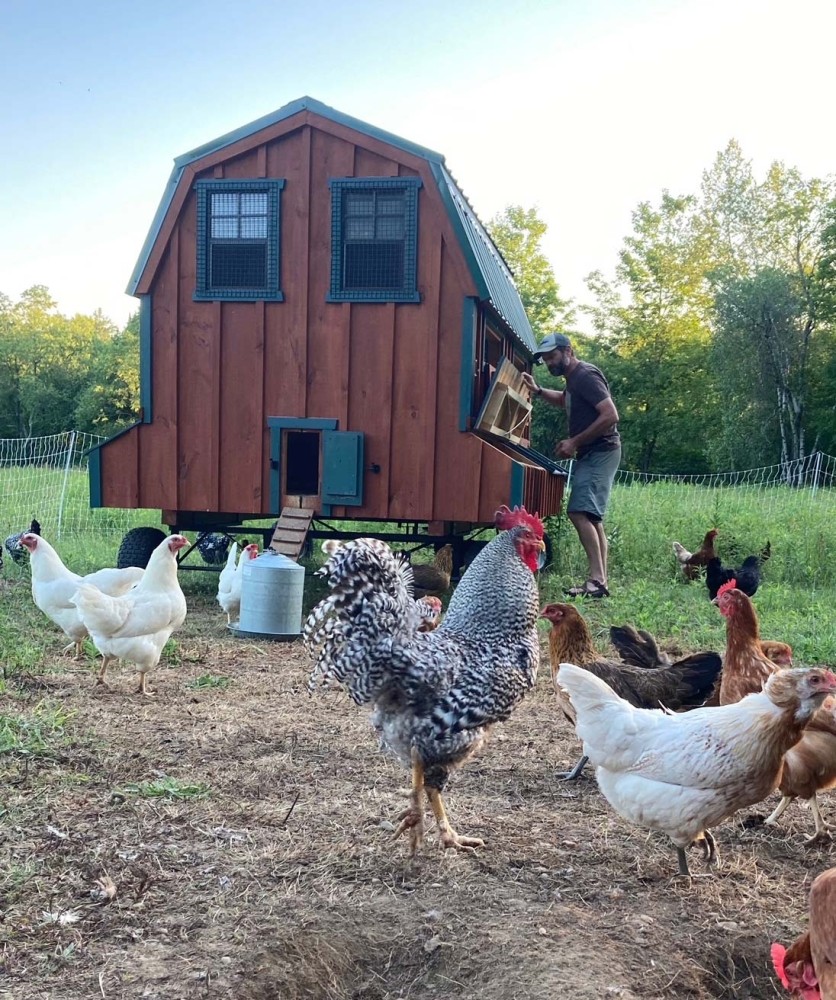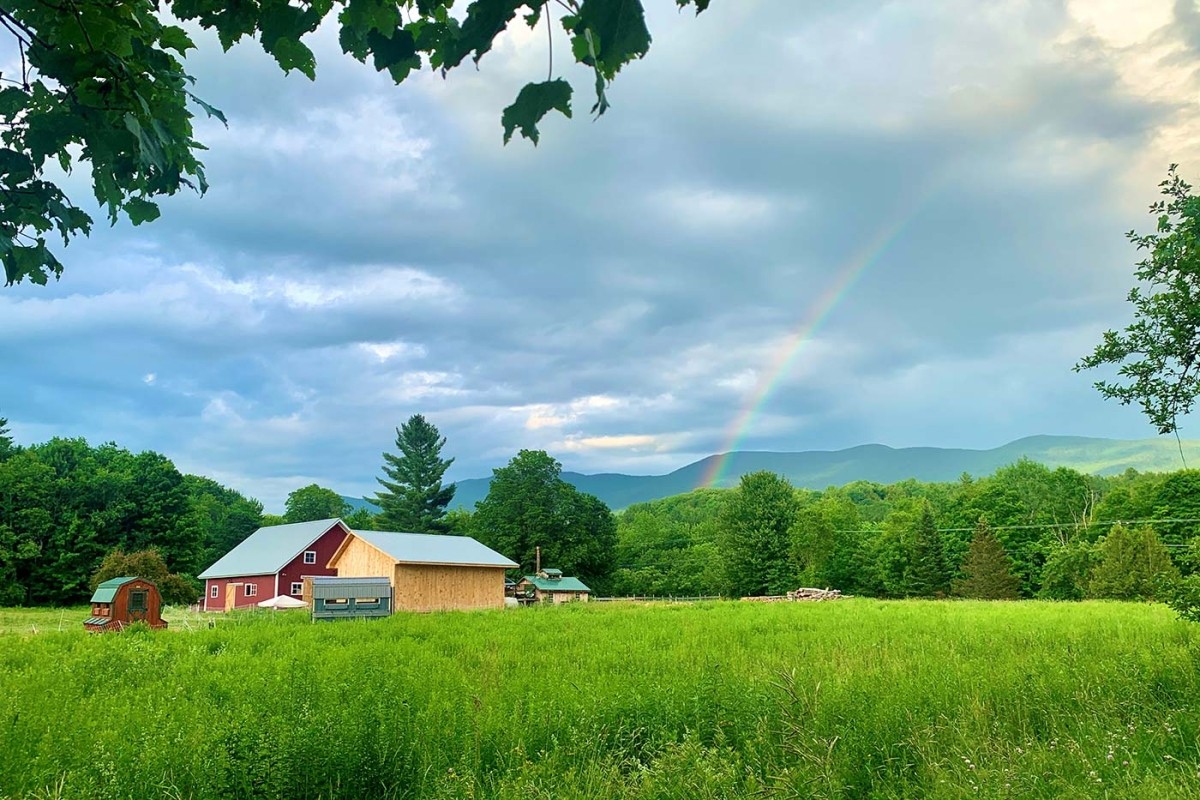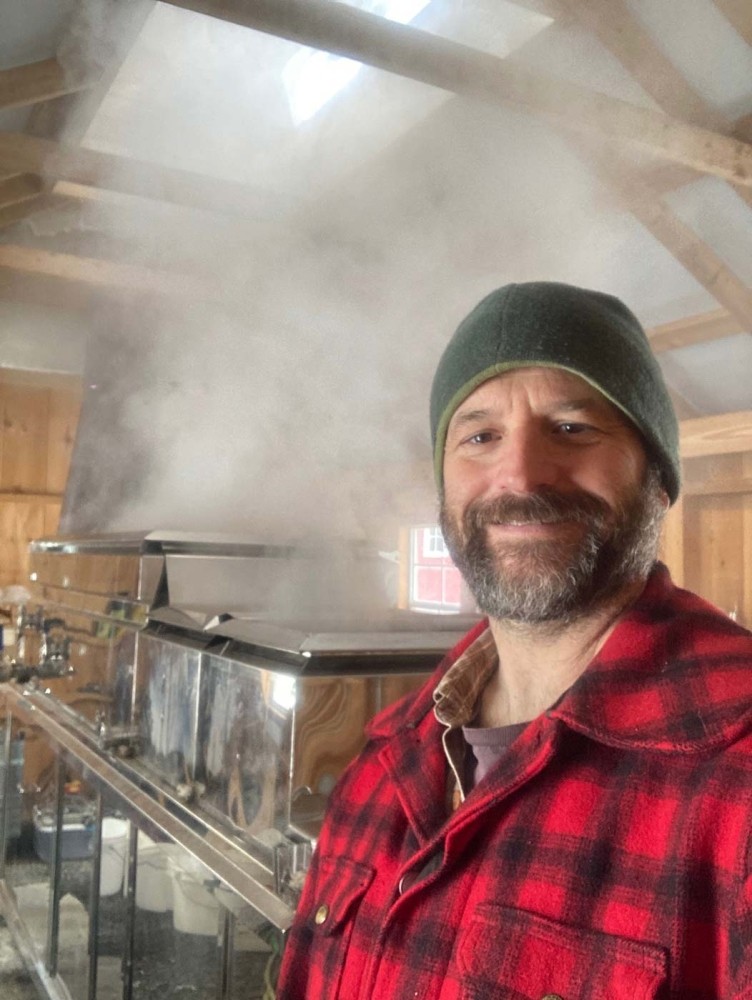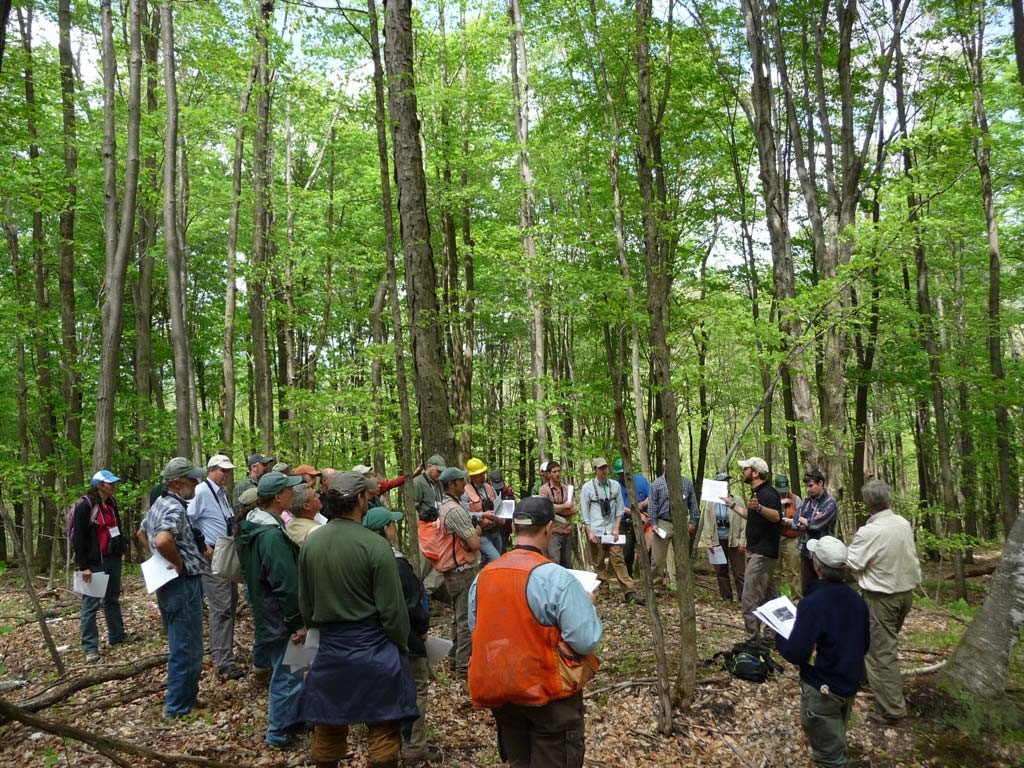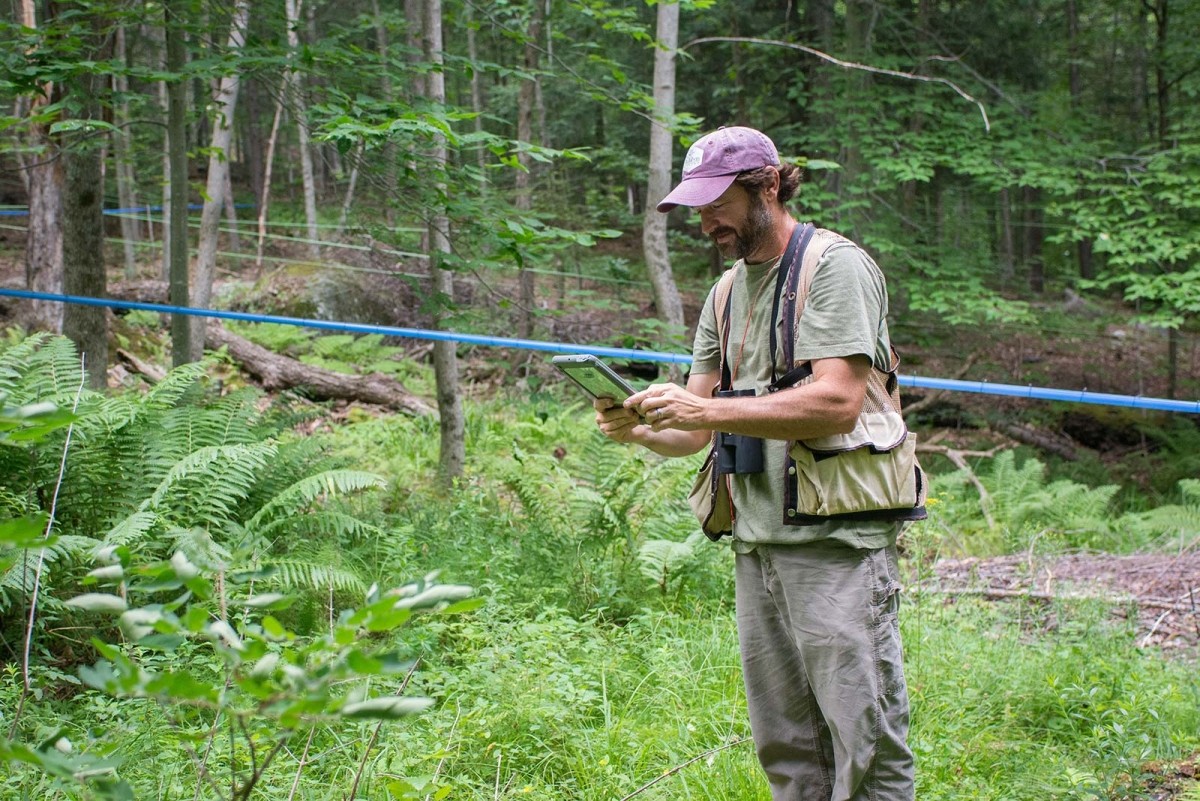Steve Hagenbuch began working with Audubon Vermont soon after moving to Vermont in 1998, and he’s remained with the organization for 23 years and counting. A conservation biologist and forester, he spearheaded the creation of Audubon Vermont’s Healthy Forests Initiative and oversees the Bird-Friendly Maple Project. With his wife, Dana Hudson, and children Grady and Willa, Steve manages the family’s Sweet Bird Farm on 9 acres in Waterbury Center, and the sugaring operation on a 76-acre woodlot in nearby Moretown.
I started off wanting to be a park ranger and ended up becoming a forester and biologist and managing all of our forest programs for Audubon Vermont. I’m still working with Audubon, but on a part time status, so that we can focus more on our own farming business. Dana and I established Sweet Bird Farm here in Waterbury Center. We raise meat birds, laying hens, meat rabbits, and sheep right now, in addition to the maple syrup we produce. We’re both very committed to an ecology-based approach to farming and understanding that our forests and farms systems are really our best natural solutions for addressing climate change, as well as being impacted by climate change.
I grew up on a farm in central Pennsylvania, in a very rural area, and said I never wanted to farm. That’s really where I got my love for being outdoors. Not farming, but just being outside in that setting. We raised beef cattle and pigs, as well as corn and wheat and sorghum and a variety of crops for animal feed. I think just being outside a lot on the farm was really influential. My grandparents had a little place about a half-hour drive away. It was in the woods, and my sister and I spent a lot of time there, building forts, making hemlock tea, and playing in the stream. No one was really teaching us what things were and all that. It was very much just the experience of being there.
As I got older and started thinking about going to college, I knew that I wanted to do something outside. And the only outdoor profession I knew about was being a park ranger. So I went to Penn State and majored in outdoor recreation and park management. In my junior year I got exposed to environmental education and thought that was really cool, so I finished my undergraduate career with a focus in environmental education and did my internship in interpretive programing. It was really fun, and I went on to spending the first seven or eight years of my career doing environmental education in residential settings, where kids would come with their school and spend a week on site. I did that mostly in New York state, but also in northern Minnesota and western Pennsylvania.
When we moved to Vermont in 1998, we stumbled across the Green Mountain Audubon Center in Huntington, and they were hiring summer day camp staff. I got that job, and I really never left. I stayed on and worked with school groups that came there on day trips. Then I became the education manager, then the center director. As I was working on my master’s degree in conservation biology at Antioch University around 2005, I was also working with Audubon to develop the Forest Bird Initiative (now referred to as the Healthy Forests Initiative). This is outreach to private landowners about how can we incorporate habitat management for migratory songbirds into the other things we want out of our forests. Then in 2014, I developed the Bird-Friendly Maple Project for Audubon, in partnership with the Vermont Maple Sugar Makers’ Association and the Department of Forests, Parks & Recreation.
I’ve been sugaring in one way or another for over 20 years. Audubon has a 500-tap sugarbush, still uses buckets to collect sap. I managed that operation for a number of years. At Sweet Bird Farm, we tapped about 100, 120 trees here when we first started. We got a small evaporator and had a small sugar house and were making maybe 20 gallons of syrup. But I wanted to do more.
About six years ago, this property came up in Moretown. It was not advertised as a sugarbush, for good reason, because it’s not what most people would see as a sugarbush, just based on the amount of maple. Right now on this 76-acre property, we’re set up for 400 taps on tubing, no vacuum, all gravity-fed tubing. Thankfully the terrain is such that there’s good downhill flow to the collection tank at the bottom of the hill. Based on forest inventory, we think we could have up to 2,000 taps.
In 76 acres, if it were a true sugarbush, in most people’s minds, it would be a lot more than 2,000 taps. But it’s a very diverse property. Maple is only about a third of the total forest, and that was attractive to me. A monoculture of anything is inherently going to lead to some bad results. Take our forest tent caterpillars, which are native in New England, and they kind of go on a cyclical basis in terms of their population. In years where their populations are high, they love sugar maple. They don’t eat red maple leaves. I’ve been in some sugarbushes that are 90 percent or more sugar maple, and they’re completely defoliated. And often that’s because they have exactly what that insect wants. If you had a greater diversity, you would still have forest tent caterpillars, but their impact would not be as great.
Disease also spreads much more easily in a monoculture. And there are wildlife aspects, too. There’s good documentation that a diversity of structure and composition of a forest is going to yield a greater diversity of wildlife. Birds are kind of an indicator of that. During my master’s work at Antioch, I looked at the implications of sugarbush stand structure and composition on songbirds and found that there is this threshold, where if you were above 70 percent sugar maple, you not only had fewer species, but you had a lower number of birds altogether. If you were less than 70 percent sugar maple, then you had a greater richness of bird species and a higher abundance of birds.
People really need to have a good understanding of what they want from their forest. So, is it enough to say, “I want to support wildlife?” Because that’s a pretty broad subject. What kind of wildlife? Wildlife that uses an older and more mature forest, or some of the game species that prefer that younger, shrubbier habitat? Helping someone to articulate what they mean when they say they want to manage for wildlife is the first and foremost thing.
The second big thing is to help people understand that active forest management – i.e. harvesting of trees – is often a really important aspect of that. Just leaving the forest to do its thing is always an option – hands-off, passive management will work. But it depends upon the objectives. Our forests are relatively young in New England. Most of them are less than 100 years old. Many of them lack the diverse structure and composition that is going to support greater wildlife. And by structure, we mean everything from layering of vegetation so it’s not just the big trees that you have overhead – you have saplings in the midstory, you have understory trees and shrubs. Different layers of vegetation support different birds. Our forests tend to not have a lot of that right now because of where they’re at age wise and developmentally. If we manage a forest, then we can help to promote some of those attributes. Active management is definitely a desired thing over some of the forests – it doesn’t have to be everywhere.
Diversity is the spice of life, and that’s true of the forests as well, in terms of the way wildlife is looking at it. Within your own forests, you want to have diversity, you want to have structure, you want to have different tree species, native plants. But also across the landscape you want to have diversity as well, so encouraging people to think about not just what you have on your 75 acres, but what’s around you? What do you offer that maybe your neighbors don’t? Don’t just think about your arbitrary boundary and what’s happening within that. Think beyond that, because stone wall boundaries and corner pins don’t mean much to the wildlife.
Vermont leads the country in maple syrup production annually. But our forests also support some of the highest richness of nesting bird species. Sugarbushes are one of our key strategies for bird conservation – to have those sugarbushes managed in a way that, in addition to producing sap, also supports a healthy and vibrant and productive bird community. With Audubon’s Bird-Friendly Maple Project, we bring that outreach to our industry and maple producers to help them understand this parallel and as a marketing angle.
We recognize maple producers who intentionally consider bird habitat in the management of their sugarbush. That entails doing an inventory and assessment of their sugarbush from a habitat view, writing up the findings, and the maple producers agree or not to managing those areas where we found as gaps between what they have and what would be most desirable for bird habitat. And if they sign off on that and agree to manage for bird habitat in the future, they get labels for their products and a sign they can hang on their sugarhouse or farmers market. I am one of those producers.
Sap production is obviously very important, but my view is it shouldn’t come at the expense of a healthy forest and a forest that supports all the other inhabitants. One example of this – I had this one beautiful dead standing tree, a snag, right in the midst of my tubing network, and the pileated woodpeckers had been working it for many years. A lot of maple producers don’t want that dead snag. That snag eventually becomes what we call down woody material – it falls down, takes out the lines, you have to repair them. Sure enough last winter, my snag came down and took a line with it. But while I may have said a few choice words when I discovered it, that’s all part of the system. If I’m going to work in the woods, which is a natural system, I need to be willing to work with that system and everything that it brings, and not just impose my own will on it.
Right now we have 60 maple producers who are part of this program, which is just a drop in the sap bucket. But we bring new people in every year. The next rendition of this program is to make it a true certification program. Audubon New York is piloting a maple program. I’m hoping to work this summer with Maine Audubon and Mass Audubon. New York is number two in the country in maple production, and Maine is number three. If we can get the top three maple producing states getting maple producers to think about the ecology of the woods and all these other things happening that we should be aware of and managing for, that’s pretty substantial.
The birds that we highlight are the top birds that I found in sugarbushes during my graduate research, and they’re birds of high conservation concern. Some of the species we talk a lot about are the wood thrush, the scarlet tanager, and the black-throated blue warbler. The black-throated blue warbler nests only in the understory, so woody-stemmed vegetation up to 5 or 6 feet in height. A lot of black-throated blue warblers tell us there’s well-developed patchiness in that forest, which we want to see – not only for bird habitat, but if some of that understory is sugar maple, then that’s the next sugarbush. All that young growth is the next forest.
The scarlet tanager is one of the birds Hubbard Brook research has shown to key in on the yellow birch and stay away from sugar maple for foraging. When we have a lot of scarlet tanagers, we can make the conclusion that there must be a good diversity of tree species. In my woods, I don’t currently have a lot of that understory layer, so I don’t hear a lot of black-throated blue warblers. I have a lot of tree diversity, though, and I hear a lot of scarlet tanagers. The birds tell us a lot about what’s going on in our forests.
Managing a forest with birds and other wildlife in mind is often made up of the same strategies that are effective for managing for climate adaptation and mitigation. It’s this complexity, diversity, composition, structure. People get overwhelmed quickly when they’re thinking about how they can mitigate climate change, but they can do this at the parcel level. Managing for timber, for wildlife habitat, for climate change – they’re not these mutually exclusive things. There are very complementary nuances between them. They can work together very well. We’re in a place where a lot of the threats to our forests we can be addressing through management, in the way we interact with the land. I think that’s promising.


